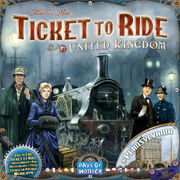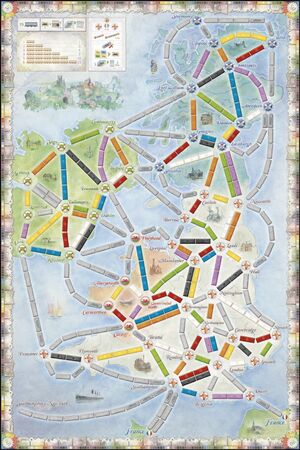United Kingdom is an expansion, which requires a base game. It comes with Pennsylvania .

Components[]
Differences[]
- Technology
- Ferries
- A singular country
- UK can only be played with 2-4 players. Also, double routes are opened in 3 or 4 player games.
- 35 train cars instead of 45.
Lore[]
Place the first rails of the glorious train adventure that all started in the United Kingdom of Great Britain and Ireland in the 19th century. Learn to master the power of steam to build trains that go faster and farther, develop your technologies, and reach the far cities of Scotland and Ireland before your opponents!
Trivia[]
- This map involves developing technologies, which insinuates a broad time range.
- The first practical use of the mechanical stoker was in 1905.
- The first practical use of superheat was in 1898. Despite being developed earlier than the mechanical stoker, and being much more commonly used in Great Britain, superheat is a higher level technology in Ticket to Ride.
- Many of the earliest locomotives used wooden lagging. The card specifically portrays mattresses of asbestos, which were used from the 1930s. Because asbestos is highly dangerous, it is no longer used.
- Boosters were first used in the UK in 1923. However, they were removed from the few locomotives fitted with them within 15 years.
- Screw propellers have been used since Archimedes, but their first use attached to steam engines was in 1837.
- Simple steam turbines were also developed in ancient times, but their first naval use was in 1894.
- The thermocompressor, also known as an injector or ejector, was patented in 1858 to allow the refilling of the boiler even at high pressure. However, the card appears to show a vacuum ejector, which is for braking.
- The equalizing beam was patented in 1836.
- Tenders were attached to the earliest of steam locomotives to carry coal and water. Tenders that exclusively carried water were uncommon until the end of steam when the destruction of water columns made them advantageous for preserved steam engines.
- Experimental diesel locomotives were developed in the 1890s, however they were not common until after WWII, when internal combustion technology had advanced enough to supplant steam. The card pictures BR 11001, a prototype built in in 1949.
- This map has the current longest route, at a length of 10. The Southampton to New York route isn't restricted by the Turbines tech.

